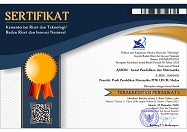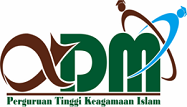EFEKTIVITAS MULTIMEDIA INTERAKTIF UNTUK MENINGKATKAN KEMAMPUAN PENALARAN GEOMETRIS SISWA KELAS VIII
Abstract
Full Text:
PDFReferences
Adefope, O. (2014). Geometry: A medium to facilitate geometric reasoning among sixth grade African-American males. Georgia Educational Researcher, 11 (1), 86-121.
Akşan, E., & Eryılmaz, S. (2011). Why don’t mathematics teachers use instructional technology and materials in their courses?. Procedia - Social and Behavioral Sciences, 15, 2471-2475.
Allen, M.J., & Yen, W.M. (1979). Introduction to measurement theory. Monterey, CA: Brooks/Cole Publishing Company.
Aloraini, S. (2011). The impact of using multimedia on students’ academic achievement in the College of Education at King Saud University. Journal of King Saud University – Languages and Translation, 24, 75–82.
Andresen, B.B., & Van den Brink, K. (2013). Multimedia in education. Bldg. 3, Moscow: UNESCO Institute.
Angadi, G.R., & Ganihar, N.N. (2015). Development and validation of multimedia package in biology. Romania: Bridge Center.
Arends, R.L., & Kilcher, A. (2010). Teaching for student learning becoming an accomplished teacher. New York, NY: Routledge.
Brodie, K. (2010). Teaching mathematical reasoning in secondary school classroom. New York, NY: Springer.
BSNP. (2015). Panduan pemanfaatan hasil UN tahun pelajaran 2014/2015 untuk perbaikan mutu pendidikan. Jakarta: Kementerian Pendidikan Nasional Badan Penelitian dan Pengembangan Pendidikan.
BSNP. (2016). Panduan pemanfaatan hasil UN tahun pelajaran 2015/2016 untuk perbaikan mutu pendidikan. Jakarta: Kementerian Pendidikan Nasional Badan Penelitian dan Pengembangan Pendidikan.
Domagk, S., Schwartz, R.N., & Plass, J.L. (2010). Interactivity in multimedia learning: An integrated model. Computers in Human Behavior, 1, 1-10.
Doolittle, E., Terry, K.P., & Mariano, G.J. (2009). Multimedia learning and working memory capacity. Dalam Robert Z. Zheng (Eds.). Cognitive Effects of Multimedia Learning. Covent Garden, London: IGI Global.
Duval, R. (1998). Geometry from a cognitive point of view. Dalam C Mammana & V Villani (eds). Perspectives on the Teaching of Geometry for the 21st Century: An ICMI Study. Dordrecht: Kluwer.
Ebel, R.L., & Frisbie, D.A. (1991). Essential of educational measurement. Englewood Cliffs, NJ: Prentice-Hall Inc.
Fischbein, E., & Nachieli, T. (1998). Concepts and figures in geometrical reasoning. International Journal of Science Education, 20, 1193-1211.
Galotti, K.M. (2008). Cognitive psychology: In and out laboratory (4th ed.). USA: Thomson Wadsworth.
Gera, M., & Vijaylakhsmi. (2015). Effect of duval cognitive model on geometric reasioning. International Journal of Research in Economics and Social Sciences, 5(9), 172-182.
Goos, M., Stillman, G., & Vale, C. (2007). Teaching secondary school mathematics. Research and practice for the 21st century. Crows Nest, NSW: Allen & Unwin.
Gunhan, B.C. (2014). A case study on the investigation of reasoning skills in geometry. South African Journal of Education, 34(2), 1-19.
Hergenhahn, B.R, & Olson, M.H. (2008). Theories of learning. Jakarta: Prenada Media Group.
Jones, K. (1998). Theoretical frameworks for the learning of geometrical reasoning. Proceedings of the British Society for Research into Learning Mathematics, 18(1&2), 29-34.
Khalid, M.S, Alias, M, Razally, W., Yamin. S., & Herawan, T. (2010). The effect of using an interactive multimedia courseware within a collaborative learning environment on the learning of pre-algebra concepts among pre-university engineering students. Procedia Social and Behavioral Sciences, 8, 571–579.
Khuzaini, N., & Santosa, R.H. (2016). Pengembangan multimedia pembelajaran trigonometri menggunakan Adobe Flash CS3 untuk siswa SMA. Jurnal Riset Pendidikan Matematika, 3(1), 88-99.
Koumi, J. (2006). Designing video and multimedia for open and flexible learning. Madison Ave, NY: Routledge.
López, C.M., Luque, R.A., & Márquez, F.A. (2011). Active learning in Operations Management: Interactive multimedia software for teaching JIT/Lean Production. Journal of Industrial Engineering and Management, 4(1), 31-80.
Malik, S., & Agarwal, A. (2012). Use of multimedia as a new educational technology tool–A study. International Journal of Information and Education Technology, 2(5), 468-471.
Mariotti, M.A. (1995). Images and concepts in geometrical reasoning. Dalam R. Sutherland et al. (Eds.). Exploiting Mental Imagery with Computers in Mathematics Education. Berlin: Springer.
Moore, K.D. (2015). Effective instructional strategies: From theory to practice. Thousand Oaks, California: SAGE Publications.
Mullis, I.V.S., Martin, M.O., Foy, , & Arora, A. (2012). TIMSS 2011 Internastional Result in Mathematics. Chestnut Hill, MA: TIMSS & PIRLS International Study Center, Boston College.
Natitupulu, E.E. (2008). Peran Penalaran dalam Pemecahan Masalah Matematik. Semnas Matematika dan Pendidikan Matematika. Diakses dari: http:// eprints.uny.ac.id/6923/1/_P14%20_Pendidikan_(Elvis%20Napitupulu).pdf [4 April 2017].
NCTM. (2000). Principles and standards for school mathematics. Reston, VA: National Concil of Teacher of Mathematics.
Neo, M., & Neo, T.K. (2009). Engaging students in multimedia-mediated constructivist learning – Students’ perceptions. Educational Technology & Society, 12 (2), 254-266.
Ogochukwu, N.V. (2010). Enhancing students interest in mathematics via multimedia presentation. African Journal of Mathematics and Computer Science Research, 3(7), 107-113.
Özerem, A. (2012). Misconceptions in geometry and suggested solutions for seventh grade students. International Journal of New Trends in Arts, Sports & Science Education, 1(4), 23-35.
Permendikbud. (2016). Permendikbud Nomor 21 Tahun 2016 tentang Standar Isi Pendidikan Dasar dan Menengah.
Reddi, U.V & Mishra, S. (2003). Educational multimedia: A handbook for teacher-developers. New Delhi: Graphic Shield.
Roblyer, M. D., & Doering, A. H. (2013). Integrating educational technology into teaching (6th ed.). Boston, MA: Pearson.
Rosnawati, R. (2013). Kemampuan penalaran matematika siswa SMP Indonesia pada TIMSS 2011. Prosiding Seminar Nasional Penelitian, Pendidikan dan Penerapan MIPA, Fakultas MIPA, Universitas Negeri Yogyakarta.
Schunk, D.H. (2012). Learning theories: An educational perspective (6th ed). Boston, MA: Pearson.
Uno, H.B., & Lamatenggo, N. (2014). Teknologi informasi dan komunikasi. Jakarta: Bumi Aksara.
Vaughan, Tay. (2011). Multimedia: Making it work (8th ed). New York, NY: McGraw-Hill.
Walpole, R.E., Myers, R.H., Myers, S.L., & Ye, K. (2012). Probability & statistics for engineers & scientists (9th ed). Boston, MA: Pearson Education.
DOI: http://dx.doi.org/10.30821/axiom.v8i1.5445
Refbacks
- There are currently no refbacks.
Copyright (c) 2019 Rusi Ulfa Hasanah

This work is licensed under a Creative Commons Attribution-ShareAlike 4.0 International License.
p-ISSN: 2087-8249 | e-ISSN: 2580-0450
Indexed by:
AXIOM : Jurnal Pendidikan dan Matematika is licensed under a Creative Commons Attribution-ShareAlike 4.0 International License.











